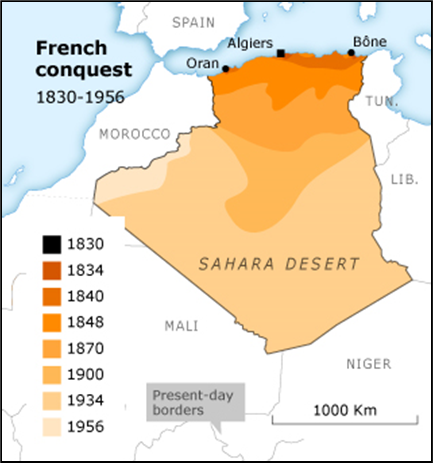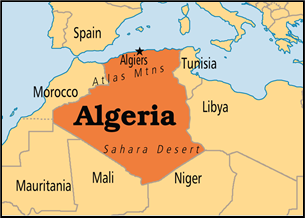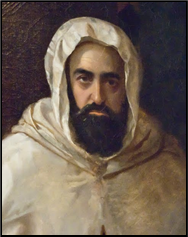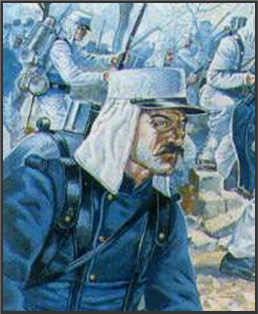


xxxxxAs we have seen, for many years the leaders of Algeria had made a good living out of piracy. The Americans, British and Dutch increased their naval action against their Barbary pirates from the beginning of the century, but in 1830 France went one step further and invaded the country. The French army quickly took Algiers and the coastal strip, but with the fall of Charles X in the July Revolution of that year, the new government had no set plan. Eventually in 1839, after an Algerian force, led by the Amir of Mascara, Abdelkader, had managed to advance near to the coast, it sent in a large army, and by 1847 had gained control of the northern region. However, the eastern region was not subdued until 1857 and the Saharan areas not until 1900. By then there was a growing independence movement, and this received a boost with the defeat of the French in the Second World War (1939-
THE FRENCH INVASION OF ALGERIA
1830 (W4)
Acknowledgements
Map (Algeria): https://chronicle.fanack.com/algeria. Map (Africa): licensed under Created Commons – jriblit.wikispaces.com. Abdelkader: detail, by the Polish painter Stanislaw Chlebowski (1835-
xxxxxAlgeria, situated in north-
xxxxxIn fact, the French had made a number of earlier attempts to gain control of this North African territory. Over the previous three years they had tried to persuade Muhammed Ali to attack the country on their behalf - also attempted, unsuccessfully, to impose a naval blockade along the Algerian coast. Eventually convinced that direct action was the only answer, they sent a military force across the Mediterranean in July of 1830. It landed in Algeria and quickly seized the capital city of Algiers. As expected, the local forces were no match for the professional soldiers of the French army. Husayn, the last dey or leader of Algiers quickly surrendered and went into exile, bringing an end to Algeria’s three hundred and more years as a province within the Ottoman Empire.
also attempted, unsuccessfully, to impose a naval blockade along the Algerian coast. Eventually convinced that direct action was the only answer, they sent a military force across the Mediterranean in July of 1830. It landed in Algeria and quickly seized the capital city of Algiers. As expected, the local forces were no match for the professional soldiers of the French army. Husayn, the last dey or leader of Algiers quickly surrendered and went into exile, bringing an end to Algeria’s three hundred and more years as a province within the Ottoman Empire.
xxxxxBut, as it turned out, the conquest was very far from over. Just a few days after the French had gained their victory, the July Revolution in Paris toppled the reactionary Charles X from his throne, and replaced him by the more moderate Louis-
 xxxxxThe new French government of 1830, having inherited the Algerian problem, tried to come up with a solution short of complete withdrawal. One was to appoint princes imported from neighbouring Tunisia to govern various parts of the country, but with the French in overall command. This proved impractical. Another was to confine occupation to the coastal areas, where control could be easily maintained, but it was feared that this would encourage rebel attacks from the hinterland. Indeed, such resistance had already begun. The Ottoman Algerian leader Ahmad Bey held out for a number of years from his base at Constantine, a city in the interior. He repulsed a French attack in 1836 before being driven from his stronghold the following year. Inxthe meantime, a more formidable opponent, Abdelkader, the Amir of Mascara (1808-
xxxxxThe new French government of 1830, having inherited the Algerian problem, tried to come up with a solution short of complete withdrawal. One was to appoint princes imported from neighbouring Tunisia to govern various parts of the country, but with the French in overall command. This proved impractical. Another was to confine occupation to the coastal areas, where control could be easily maintained, but it was feared that this would encourage rebel attacks from the hinterland. Indeed, such resistance had already begun. The Ottoman Algerian leader Ahmad Bey held out for a number of years from his base at Constantine, a city in the interior. He repulsed a French attack in 1836 before being driven from his stronghold the following year. Inxthe meantime, a more formidable opponent, Abdelkader, the Amir of Mascara (1808-
xxxxxIt was at this point that the French government opted for all-
xxxxxAndxto complicate matters, the French war in Algeria had brought neighbouring Morocco into the conflict. In 1844 Abdelkader had taken refuge in Morocco and forced the Sultan to support his cause. This brought about a French invasion and a convincing defeat of Moroccan forces at the Battle of Isly. Thexresult was the Treaty of Tangier in October 1844 (Va) by which the sultan was obliged to  recognise France’s claim to Algeria. This settlement preserved Moroccan independence for the time being, but this was to change with the First Moroccan Crisis and the Algeciras Conference which followed in 1906.
recognise France’s claim to Algeria. This settlement preserved Moroccan independence for the time being, but this was to change with the First Moroccan Crisis and the Algeciras Conference which followed in 1906.
xxxxxIncidentally, today the Algerian people regard their military and religious leader Abdelkader (illustrated) as the saviour and founder of their state. Not only did he lead his nation in its struggle against French domination, but during a period of truce in the 1830s he unified much of the country, and laid the first foundation stone of a nation in the making.
Including:
The French Foreign Legion

xxxxxThe French Foreign Legion, a corps open to volunteers of all nationalities, was founded in 1831 during the French war in Algeria in order to help control France’s colonial possessions in Africa. At first it attracted a large number of undesirables, such as criminals on the run, but it is now recognised as a well-
 xxxxxIt was in 1831, during the French war in Algeria, that the French Foreign Legion (now generally known as the Foreign Legion) was founded. Established in the reign of Louis-
xxxxxIt was in 1831, during the French war in Algeria, that the French Foreign Legion (now generally known as the Foreign Legion) was founded. Established in the reign of Louis-
xxxxxThe majority of officers are from the French army and those who are not French -
W4-


